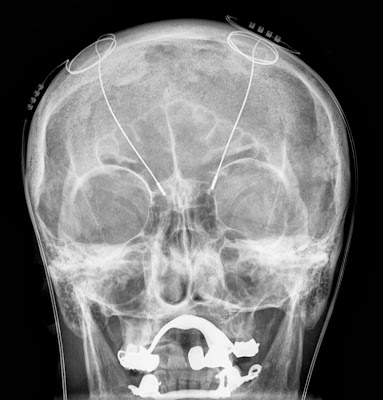In June of this year, a video came out on Youtube that has
now achieved over 1 million views. Unlike may viral Youtube videos, it is not
images of cats chasing lasers, or people running into glass doors. Instead, it
is of a man, sitting down in a chair talking to the camera. This man’s name is
Andrew Johnson (AJ), and 4 years earlier at 35, just starting a family with 5
and 3 year old children, he was diagnosed with Early Onset Parkinson’s Disease.
You would not know this by looking at the video though. Parkinson’s Disease is
a progressive disorder affecting motor movement, most famously tremors and
stiffness/slowing. The AJ on camera’s movements are fluid, his speech is normal
and understandable. He goes through some simple motor tests with his hands,
showing complete movement. AJ then goes on to explain in 2012, he underwent
surgery for Deep Brain Stimulation (DBS). He picks up a remote control, puts it
to his chest, and pushes a button. Almost immediately, his hand starts to
tremor. He holds his hands up and they blur in front of the camera. His neck
tightens and his head tilts. His speech is slow and broken. With trouble, he
grabs the remote again and turns his device in his chest back on. Again, almost
immediately, he is returned to his original state.
At first watch, it is hard to believe. It seems that
science has founds a complete cure for Parkinson’s. This is not the case
though. DBS does not stop Parkinson’s symptoms as seen when AJ stops his
stimulator, and it is often used alongside other treatment methods. It does not
stop the progression of the disease either, and because of that the DBS must
continually reprogrammed.
What DBS
does do is treat some of the motor symptoms of Parkinson’s. Thin electrodes
inserted into brain target motor circuits that are not working properly. A
device implanted in the chest acts like a pace maker and shoots electrical
impulses through the electrodes deep into the brain, mainly the Globus Pallidus
and Subthalamic Nucleus regions. These signals take the place of the overactive
or underactive signals from the non-working motor circuits causing the motor
symptoms. In the x-ray below, you can see the two thin electrodes inserted
bilaterally into the center of the brain, then coiled up on the top of the
skull and running down the sides (the white sections around the teeth are dentures).
This
surgery is an option for certain kinds of Parkinson’s patients. The main
problematic symptoms for these patients are motor, most often tremors (also
called dyskinesia). These symptoms must not be treatable with common Parkinson
medication like Levodopa, or in some cases, the medication can cause too many
adverse side effects. DBS can reduce these motor symptoms drastically without
as many side effects. Again, it is not a cure all though. Most patients need to
supplement DBS with medication. DBS also has cognitive effects on certain patients.
Parkinson’s can cause, especially in the later stages of progression, serious
cognitive deficits. In these patients, DBS can increase these symptoms. Just
when you gain back you motor functions, you loose your mental ones.
Even with
all this, DBS is a life changing chance for many Parkinson’s patients like AJ.
Because these patients are completely while they slowly loose the ability to do
every day activities, it is an extremely hard disease on the mental state of
its victims and their families. AJ continually repeats this in his blog, which
I will link to at the bottom of the post.
For cases like AJ, DBS is a procedure that can completely
change how patients are able to interact with their family and life, allowing
them to enjoy more than previously thought possible in the face of this
debilitating disease.
To learn more about AJ’s experience:
AJ’s amazing viral video: http://www.youtube.com/watch?feature=player_embedded&v=uBh2LxTW0s0
AJ’s blog Young and Shaky following his progression from
diagnosis to surgery and beyond: http://youngandshaky.com/
To learn more about DBS:
The National Parkinson’s Foundation’s:
A TED talk by the pioneer of DBS about its functions beyond
Parkinson’s:
A 3D animation of how DBS works:
A video from the Mayfield Clinic explaining the procedure:
*WARNING* This video does show the entire DBS procedure,
including drilling into the skull and inserting electrodes. Do not watch if
open-wound-shy.
To Radiolab for first introducing me to this article:

No comments:
Post a Comment